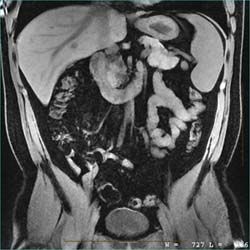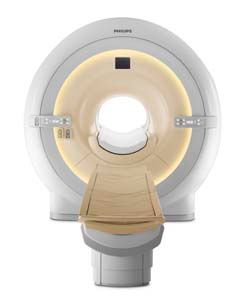MR vendors look for patient-focused route to success
In the gleaming technical exhibition at ECR 2009, vendors of MRI systems are showing just how their latest innovations will help turn the imaging examination into a faster, less claustrophobic, and altogether more pleasant experience for the patient.
In the gleaming technical exhibition at ECR 2009, vendors of MRI systems are showing just how their latest innovations will help turn the imaging examination into a faster, less claustrophobic, and altogether more pleasant experience for the patient.
Philips is unveiling its new Achieva 3T TX unit, which it describes as one of the most powerful systems currently available, enabling clinicians to obtain high-quality results across a wide range of applications and patient sizes.

The Syngo Blade facility allows motion artifact compensation, even in the case of severe movement. (Provided by Siemens)
Guido Stomp, director of the Philips Healthcare MR business line, explained that the improvement in performance with the new model has resulted from a change of emphasis from the radiofrequency signal receiving technologies to the signal transmission side. The product is equipped with a multiple transmission source that allows a uniform distribution of signal across the part of the body under examination. By adjusting the RF signal, the system is able to eliminate the dielectric shading artefacts that remain a major problem with 3T MRI.
"This means that we have far fewer repeat scans. The patient spends less time in the scanner, and there is a faster throughput of cases," he said. "But there is not just a reduction in the number of retakes. The actual scan time can be up to 40% faster, which will make a considerable difference in situations like spinal imaging, where there is normally a need for high signal intensities."

Abdominal image taken on a Signa MR750 3T device using the LAVA-Flex application, a dual-echo acquisition technique that reportedly provides consistent, detailed 3D abdominal images in one breath-hold. User can select different output image types: in-phase, opposed-phase, water, and fat. (Provided by GE Healthcare)
Improvements in the consistency of the images created will broaden the clinical utility of 3T systems, Stomp said. Three-T machines have proved their worth in neuro and skeletal imaging, but problems with artifacts have sometimes limited their value in full-body imaging. He hopes that this ability to adapt to patients with wide variation in fat and fluid distribution will bring new opportunities for hospitals away from the main academic centers, which need to carry out larger numbers of breast, liver, and abdominal examinations.
The clinical potential of the Achieva 3T TX is being assessed at the University of Bonn, Germany, and the machine will become commercially available later this year.
Part of Siemens' strategy for making examinations more comfortable has been to design systems that look less intimidating. Its latest product is the Magnetom Espree -- Pink. This dedicated 1.5T MR breast system combines the open-bore design of the Magnetom Espree with the Sentinelle Vanguard, a coil for breast imaging and biopsies.

Philips introduced its Achieva 3.0T TX system at ECR 2009.
Allowing for both feet-first and head-first positioning, the new unit is 125-cm long and has a 70-cm open bore to enhance patient comfort and allow easy access for biopsies. It also offers a comprehensive portfolio of routine and advanced applications for breast care, including syngo VIEWS for routine imaging, syngo GRACE for spectroscopy, and syngo BLADE for motion-free imaging results.
Siemens is also showing its innovation for oncology imaging, Tim (total imaging matrix). Its features include syngo Tissue 4D, which offers dynamic evaluation with quantification of tumor tissues in organs such as the prostate and liver. This provides two evaluation workflows: standard and pharmacokinetic modeling. The latter function quantifies the uptake of contrast medium and can be used for oncology workflow and follow-up studies.
GE Healthcare is showcasing the Signa MR750 3T, launched in Paris last October. This product reportedly delivers up to 60% additional anatomical coverage and resolution compared with conventional systems, but the emphasis in the design process has been as much on simplicity as on its technical performance, according to Stefano Vagliano, general manager for MRI technologies in the European region.
"It has a console on the machine itself, which enables radiographers to carry out many of the actions that they would normally have to do outside the room," he said. "They can stay with the patient while they set up the exam, and our new software also simplifies the setup, which means they can concentrate on looking after their patient."

MultiTransmit effectively addresses dielectric shading, even in patient with liver cirrhosis and ascites. Ascites patients are often challenging to image with MR due to shielding effect of fluids. Large image: MultiTransmit. Inset: conventional 3T. (Provided by Bonn University Hospital, Germany, and Philips)
The new system can also reduce the time spent by the patient in the MRI suite. Its new RF Transmit system maximizes performance with a 17% gain in scanning efficiency, while the Optical RF technology allows up to a 27% higher signal-to noise-ratio. This reduces the number of acquisitions needed for a comprehensive breast examination from four to two and will cut the time needed for a full liver study from at least 25 minutes down to 15 minutes, he said.
Hitachi Medical Systems has also made patient comfort a priority in designing both the Oasis 1.2T and Echelon XLS 1.5T machines. These products feature a number of new applications, including high-resolution dynamic breast imaging with TIGRE, comprehensive motion-compensated free-breathing abdominal studies with RADAR, noncontrast MRA with VASC, brain ischemia assessment with Advanced NeuroSuite, and white matter disease assessment with Diffusion TensorSuite.
Oasis incorporates a 1.2T vertical field magnet designed to meet the demands of today's advanced studies and image quality requirements. Its unobstructed viewing angle puts even difficult patients at ease, which decreases scan time and increases throughput.
Study: Monitoring of Prostate MRI Exams Could Lead to 75 Percent Reduction of Gadolinium Contrast
March 17th 2025While DCE MRI was deemed helpful in over 67 percent of cases in which it was used, researchers found that monitored prostate MRI exams, which facilitated a 75 percent reduction of DCE MRI sequences, had comparable sensitivity for prostate cancer as non-monitored exams.